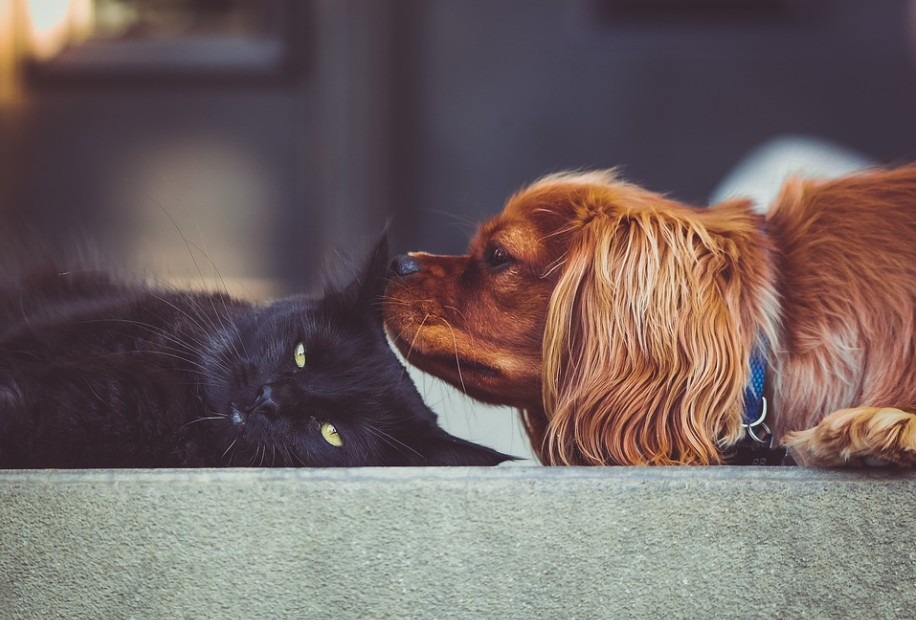We use the cliché “fighting like cats and dogs” as a natural law, although many houses have both animals living together happily. Do they become best friends as a result of this? Is it possible that they are similar because they share the same social and physical environment?
Cats and dogs communicate uniquely and have very different social structures. Harmony is not a certainty!
Behavior
The behavior of an animal contributes a lot to its bond with others. Dogs are predators by nature, and they frequently pursue prey that is smaller than them, including cats. However, this does not rule out the idea of dogs and cats coexisting!
As the two most common household pets, dogs and cats interact with one another have a lot to do with their temperament.
A dog lifting his paw to a cat, for example, may indicate that he wants to play, but a cat may see it as an attack, prompting the cat to swipe her paw at the dog, causing her to hiss.
Similarly, a cat rubbing up to a dog may appear friendly, but a dog may interpret this as a danger. It can make the dog growl or bark, especially if the cat is near toys or food. It is possible to get a dog and a cat at about the same time and raise them together.
Unless one of the animals is particularly hostile and dominant, neither have any previous phobias of the other.
Types of Relationships
1. Rude Relationship
As mentioned above, many animals get addicted to being hostile. In a cat and dog relationship, cats are always seen as mischievous and might be. The nature of cats is to own everything belonging to their owner.
As a result, they may be arrogant towards the other pet especially, if it is a dog. Owners usually show equal love to their pets. Cats might get jealous of the dog and make them uncomfortable.
On the other hand, many breeds of dogs are harsh. The reason might be the abandonment from their previous owners or birth. Dogs are lovable animals!
However, they may act violently towards their fellow pets when in distress.
2. Friendly Relationship
Cats and dogs may coexist together and build bonds. You may own a cat or a dog as your first pet and cats hissing at the dog and him barking at the cat.
However, just as humans, if you interrogate, they can become best buddies!
Now, You might be looking forward to how to make your pets more amicable to one another?
Below is discussed the way to make them friendly towards each other!
How to Make Them Friendly Towards Each Other
Friendships take time to form, just like they do with people, so don’t be disappointed if your pets don’t become pals straight away. While many cats and dogs do not get along straight once, there are certain things you can do to help them acclimatize to living together.
You may establish a joyful, calm household by taking your time and learning what each of your dogs requires. Keep the following in consideration when introducing a cat into a dog-only house or vice versa!
1. The Introduction
1. Go Slow!
Allowing your dog to chase your cat around is not a good idea. Separate the pets at first, waiting three or four days before introducing them face to face. Animals need time to evaluate each other’s odors and homes before they could even deal with getting to know an animal.
- If you force cats and dogs together unexpectedly, they are considerably more likely to fight or be unhappy. Separate them and keep them out of each other’s sight until they are both calm.
- Begin by caressing the cat, then the dog, and vice versa to mix the animals’ scents (with pets in separate rooms)
2. Alternate the rooms you keep the animals in
It allows them to sniff where each other has been without the presence of the other animal.
Smells are a significant way for animals to communicate with one another. Allow your animals to get to know each other’s scents before meeting them face to face.
- Rub a towel on your dog and then place it under your cat’s food bowl. It will assist your cat in becoming accustomed to the dog’s scent and accepting it.
3. The Smell Familiarisation
Even if they can not see the animal, this will help them associate the new aromas they are smelling.
- Feeding the cat and dog on opposite sides of the same door is a good idea. It will drive them to acclimate to the other animal’s odor.
4. Make Plans for a Peaceful Gathering
Wait until your cat appears relaxed and ready before introducing your dog.
You should give the cat extra time if it is scared and runs and hides every time the dog approaches the door to their chamber. It may be time to see each other once the cat has accustomed to the dog’s smell and sounds.
5. Allow Physical Interactions
Then have a family member or friend carefully bring your dog into the room on a leash. Bring the dog closer in gradual steps, waiting for both your cat and dog to relax down before proceeding. Allow the animals to come into physical touch with each other only to get them acquainted with each other’s presence.
- Make sure you only hold the cat if it is content to be touched
- To protect your arms from scrapes, wear long sleeves.
- Another alternative is to keep the dog or cat in a crate while the other animal roams freely.
- It will ensure that they do not make physical contact when they first meet.
6. Love them Equally
As you introduce your pets to one another, provide them both equal amounts of love.
Animals, like us, grow resentful when ‘the new youngster’ receives more attention than them. Demonstrate to both of your pets that you care about them and that the other animal should not be afraid.
7. Separate Your Pets Once Again
Avoid making them interact for too long; this will exhaust them, potentially resulting in conflict. Keep the initial encounter brief and pleasant to ensure a positive experience.
- Increase the length of these sessions gradually.
8. Continue the Interaction Until they are Relaxed
Keep the dog on a leash until the cat appears to be at ease, but allow the cat to roam freely in the room. After a few weeks of training, the dog will not chase the cat, allowing you to let it off the leash.
- Pheromones, obtained from your veterinarian, can also be used to keep both animals quiet and content.
- Inquire with your veterinarian about the possibilities of utilizing synthetic hormones to help your pets adjust.
2. Adjusting Your Pets to Live Together
1. Keep Control
When you are not at home or with your pets, keep them separated. Follow the steps for a long time to avoid your cat and dog injuring each other.
- Redirect negative behaviors that your dog directs at your cat
- Roughhousing and barking are examples of this. Distract your dog with another activity or some obedience training instead of letting it focus only on the cat.
- In this situation, try to avoid scolding your dog. Maintain a good attitude in the scenario, and your dog will be more likely to form pleasant connections with the cat in the future.
2. Reward and praise them
It can range from being pleasant to ignoring the cat. Make it such that your dog enjoys treating the cat properly when it enters the room, rather than being aggressive or overly attentive to it.
- Let’s say, “Puppy, look! Kitty has arrived! That’s fantastic! “and you appear to be in good spirits. After that, reward the dog with a training treat. Your dog will quickly learn to equate the cat with good feelings.
3. Provide Your Cat with a Place where it is Out of Reach From Other Pets
As long as your cat can get out, it can be anything from a cat tree to a baby gate across a doorway. Cats will usually attack a dog only if they get trapped in a corner with no way out
4. Have Realistic Expectations
Your dog or cat may not know how to handle the situation straight away if it has never lived with another animal before.
Furthermore, you will not know if your dog will regard the cat as play or prey.
You would not know whether your cat sees your dog as a threat or a curiosity. Understanding that there may be a long period of acclimatization between you and your partner will help you stick with the process of getting them to get along.
Bottom Line
For ages, dogs and cats have been portrayed as enemies. They do, however, coexist peacefully in the majority of households. The essay delves into the specifics of their relationship and suggests solutions to bring them closer together.
We recommend checking the best multivitamins for cats!

